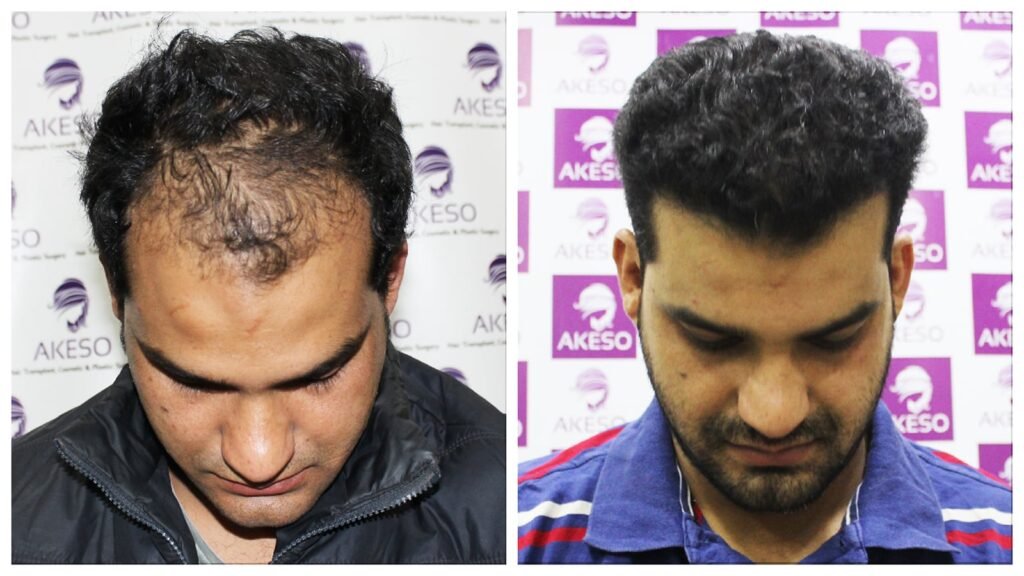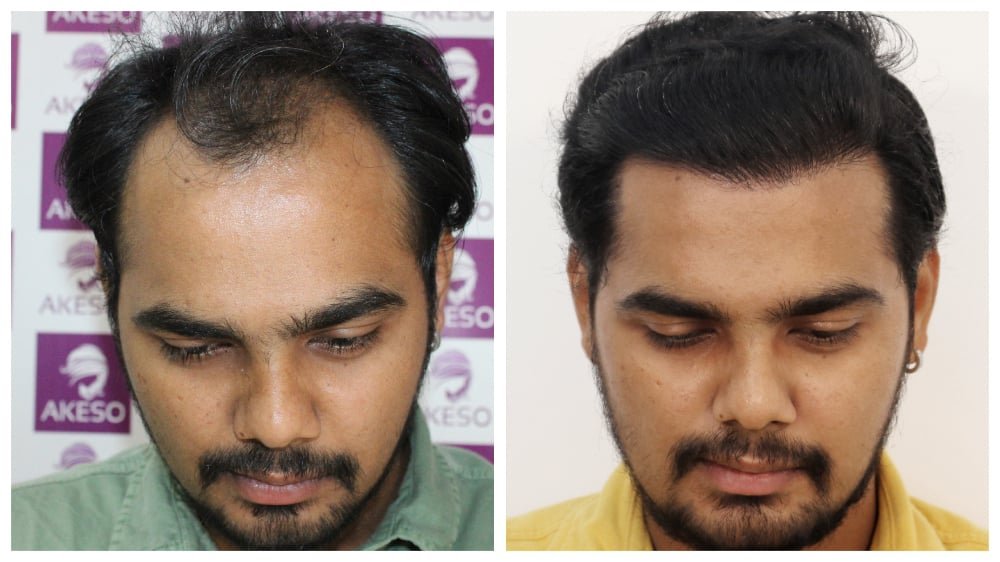+91 9643262655
AKESO MSDF TECHNIQUE
How MSDF Differs from Traditional FUE:
Standard FUE often involves a one-step sharp punch dissection by Rotation, which can risk transecting follicles and damaging surrounding tissues.
MSDF, in contrast, allows for a controlled, stepwise dissection in which upper layers of the graft with hard tissue, like skin and gland, are cut by rotation and inner soft layers are cut by oscillation so that it better preserves graft quality and minimizes damage. It is an ideal technique for achieving high-density, natural results with fewer complications.
The MSDF technique is time-intensive and can increase surgeon fatigue due to the careful control required at each stage. However, the long-term benefits of healthier, more robust grafts make it a premium option for patients seeking high-quality hair transplants.
AKESO MSDF TECHNIQUE
AKESO MSDF (Multi-Stage Deep Follicular Dissection FUE) is an advanced, multi-step follicular extraction method focusing on careful dissection of the surrounding tissue around each follicular unit.
Here’s a detailed breakdown of how the MSDF technique works, along with its advantages. MSDF is a Multiphasic FUE graft extraction method, so we will first describe the points in sequence
In multiphasic FUE –
The use of rotation, oscillation, or a combination of rotation and oscillation (rotoscillation) instead of only rotation for FUE.
The upper layers are hard, so they require rotation to cut. Deeper layers are soft, and part of the hair graft inside the softer fat layer is very flexible and curly or splayed, so it can be damaged by rotation. Oscillation or vibration is a soft force that dissect deeper layers.
Multiphasic FUE devices
All devices available in the market, like Trivellini and WAW devices, can use rotation, oscillation, and vibration based on timers rather than the depth of punch insertion. They work on the hypothesis that rotation damages the inner layers, but oscillation causes less damage. In these devices, you can set rotation movement time, oscillation movement time, and repeat cycles.
In these Multiphasic devices, the surgeon has to set an approximate time when he expects to cross the upper layers. This means he has to set a time in the machine and make sure that the rotation phase duration is just enough to cross the upper layer. If he remains superficial during that time, then the skin and graft will buckle, and the graft can be buried or damaged. If he is too fast, then rotation may reach deeper layers, where the graft can be cut.
AKESO MSDF VS TRADITIONAL MULTIPHASIC FUE DEVICE
AKESO MSDF also works on the same principle as multiphasic devices, but the difference is that the surgeon decides for each graft depth and has to use a foot paddle to stop rotation at the correct depth. Although MSDF does not require oscillation in the second phase, oscillation can be used in harder tissues. In MSDF, the surgeon can decide at what level of depth he wants to stop rotation by pressing the foot pedal of the MSDF machine.
The only disadvantage of MSDF is that it is much more tiring for the surgeon, as he has to concentrate more and press the foot pedal in fractions of seconds. If the surgeon wants to extract 1500 grafts in one hour, then he has to press the foot pedal 1500 times in MSDF. In normal FUE or Multiphasic devices, we can set timers so they are less tiring.
Prerequisites of performing AKESO MSDF Technique
- AKESO MSDF MOTOR—D AKHILESH JANGID made the MSDF motor through independent research. This motor can switch rotation to oscillation or vibration in just 100 milliseconds by pressing a foot switch. We had tried automation by timers in the initial phase, but a timer is not a perfect solution. So right now, it is manual switching. New methodologies are being tested, like pressure sensors, to reduce surgeon fatigue, but currently, they are in an experimental phase.
- AKESO MSDF PUNCH is a circular blunt punch with sharp teeth in some places. As the edges of the sharp teeth are beyond the blunt edge, the sharp teeth cut the tissue when the punch rotates. When the punch is stopped or vibrates or mildly oscillates, sharp teeth are not able to cut the tissue. When hair or any hard tissue comes in front of sharp teeth in vibration or low arc oscillation phase, the Punch displaces the hair rather than cutting it, and the hair goes to a blunt edge, so it gets protected even if we go into deeper layers. You can also easily go to a depth of 4 – 4.5 mm without cutting the graft.
- Expert Surgeon—The Surgeon has a big role in AKESO MSDF, as only the surgeon can decide when to stop rotation. If the surgeon stops rotations prematurely, the skin may be tented, and the graft may be buried. If the surgeon is late to stop it, the graft may be cut.
- Magnification – Besides tactile feed, the surgeon should be able to see the depth of the punch along with the hair angle premises. So, it should be done using surgical loupes of 4X – 6X or a microscope. Surgeons using Optivisior, specs, naked eye, or 2 X magnification cannot learn or perform it. The best is to do it with a Microscope (MAGP PROCESS).
Key Benefits of MSDF Technique:
REDUCED GRAFT DAMAGE – Graft transection rates are low even when we work in deeper layers of skin
Enhanced Graft Quality: By carefully dissecting around the follicle in multiple stages, MSDF ensures that each graft retains more fat around the root, which leads to more robust and healthier grafts. These grafts are less likely to be damaged during extraction, improving their chances of survival when transplanted.
Reduction in Mechanical and Heat Damage: MSDF avoids this by stopping the punch after the superficial dissection and relying on blunt forces for deeper extraction. This minimizes heat generation and minimizes tissue damage. Because the motor stops repeatedly, the heat produced during rotation also dissipates.
Improved Outcomes with Small Punches: MSDF ensures the grafts are still bulky and healthy even when using smaller diameter punches, reducing the risk of “stripping” or damaging the follicles during extraction. This is a significant advantage in achieving natural-looking, dense hair transplants.
Increased long-term results: The enhanced preservation of the surrounding tissue, fat, coupled with the precision of the technique, leads to higher graft survival rates and more life. This is particularly beneficial for patients looking for high-density, natural results from their hair transplant.
Natural looking hair transplant results
Natural looking Results with high density hair transplant






Heartfelt Testimonials from Smiling Faces Everywhere
4.5 Customer Reviews
EXCELLENTTrustindex verifies that the original source of the review is Google. Want to share my own experience regarding Akeso hair transplant is unbelievable.. though I was scared about treatment or result but when I had this in last may 2024 it was wonderful treated by Doctor Akhilesh and their staff.. after two or three months I saw the result as proper new hair what I didn't expect,. Today after seven or eight months there is full growth of hair on all transplanted area. I suggest to all viewers visit 'Akeso Delhi India' once and experience the truth.Trustindex verifies that the original source of the review is Google. I was searching for the best hair transplant options in India and eventually decided to visit Akeso Hair Transplant Clinic,Delhi , traveling all the way from Kolkata. I received exceptional care from Dr. Akhilesh, who is highly skilled in this field. Three days ago I have finished my hair transplant in Akeso . The main reason I choose Akeso Hair Transplant clinic for my transplant is that the role of doctor in the hair transplant procedure is maximum in Akeso compared to other hair clinic . The staff at the clinic was very professional and attentive, ensuring that I felt comfortable throughout the entire process. I highly recommend Akeso Hair Transplant Clinic to anyone considering a hair transplant; their expertise and commitment to patient satisfaction truly set them apart.Trustindex verifies that the original source of the review is Google. Authentic place, The doctor was very good and the entire procedure was done by him.Trustindex verifies that the original source of the review is Google. I had my hair transplant done last year in July for 2500 grafts. After that, I had been on medication. I am completed satisfied with my hair growth result. I recommend everyone to visit Akeso hair transplant centre.Trustindex verifies that the original source of the review is Google. Thank you so much for the hair Transplant. I have got 3500 grafts transplanted done by Dr.Akhilesh Jangid. I am from Hyderabad and little hesistant to visit Delhi. I tired to look for clincs in my city but doesnt noted any clincs which use new technology like Microscopic and implanters, which improves the result. I noted that Akesko clinic using this technology. The role of doctors in this Hair Transplant is more when compared to other clinic. Initially, I was unsure about the process, whether it's painful or how much is the sucess rate. But, After talking to Akhilesh Jangid (3 times through video consultation) and reading the reviews, I got confidence in the process. The hair transplant went very smooth and before performing, each step is explained. I am very thankful to Doctor and staff, they are very polite and helpful in answering my all questions throughout my hair transplant journey.I personally recommended this clinc.Trustindex verifies that the original source of the review is Google. Je suis pleinement satisfait de mon intervention chez AKESO. Tout était clair et transparent dès le départ, ce qui m'a amené à effectuer mon intervention chez eux. Le médecin ainsi que ses assistants ont toujours été patients pour expliquer et reexpliquer les choses qui n'était pas clair, dans cette aventure longue et complexe. Un grand merci au Dr Akilesh et à son équipe.Trustindex verifies that the original source of the review is Google. I have visited Akeso (Dr Akhilesh Jangid) for hair transplant on 10th of June 2024. It's been 6 months now and I have seen significant growth of hair on my scalp. Considering just 3600 implants I am really satisfied with the result. With two free PRPs I am hoping to improve the hair quality even further.Trustindex verifies that the original source of the review is Google. Akeso is the best option for hair transplant. Dr Akhilesh Jangid is the best hair transplant doctor. I would recommend everyone who wants to or is planning for hair transplant, he or she should undoubtedly go for akeso. Thank you akeso 🙂


